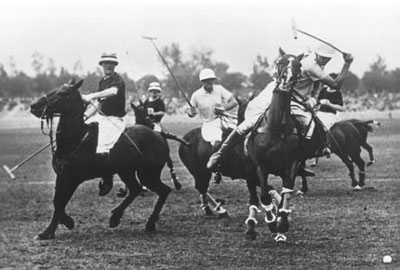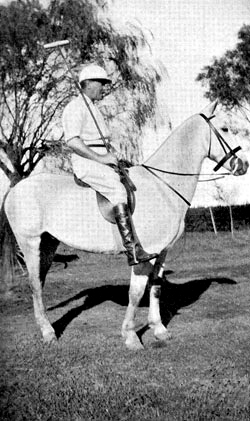|

Argentina (white) vs.
Great Britain during the Olympic Games at
Berlin,
August 1936. The Argentine team won 11-0
(Musée Olympique, Lausanne)
|
In
1898 The Casuals won the Open for the second time, having
first won it three years previously, with a team formed by
the brothers Roberto and Eduardo Traill. Six years later,
in 1904, ‘North Santa Fe’, achieved their first victory and would go on to be
one of the most successful teams of the era. The victory
was noteworthy as the team comprised three brothers and a
cousin: Roberto, Eduardo, Juan and José Traill.
Thereafter, a Traill appeared on the winners’ podium in
the Open on six occasions. An all-family affair again
ensued in 1908 when the three Traill brothers and their
cousin José won the Open.
The
Traills owed much of their success to their pioneering
pony breeding, as The
Polo Monthly recorded: ‘They were the first breeders
in the Argentine to play ponies bred by themselves for
polo, and their ponies by their first stallion, Spring
Jack, marked a change between the old-fashioned Argentine
pony and the blood of today’.
The
most outstanding member of the family was Juan A. E.
Traill, the first to obtain the maximum handicap in Argentina
of ten goals, in 1913. Although Argentina claims Johnny Traill as her own, he had, in a sense,
triple nationality. By descent, he was a member of an old
Anglo-Irish landed family, settled in
County Down, by upbringing he was Argentine, and by birth English, as
he had been born in London. He was born on 8 December 1882. All of his brothers and
sisters were born in Argentina, on the family estancia ‘La Esterlina’, in the north
of Santa Fe province.
The
1911 polo season was memorable for Johnny. Playing for
North Santa Fe, with his cousin Joe, Francis Geoffrey and
Leonard Lynch-Staunton (a native of County Galway, who was
three times winner of the Argentine Open), they took part
in thirteen matches, winning every one, scoring a total of
175 goals to 11. The fame of the ‘asesino
latinoamericano’, [2] as he was known, transcended
national borders and he soon began playing abroad.
In
the 1920s, after marrying Irish-Argentine Henrietta
Roberts, he settled in England, where he had a distinguished career and was considered
one of the best players of the era. He won numerous
tournaments, such as the Ranelagh Championship in London, the Westchester Championship in
New York, and others. Along with his cousin Joe, he joined the
Ireland team, which represented the country in the Patriotic Cup.
With his sons Jim and Jack he formed his own team, ‘The
Traillers’, winning a number of tournaments in the
1930s. He died in 1958 and the family polo tradition
continues to this day with his grandchildren and
great-grandchildren. One of his descendents Lucía Escriña
Traill features in the current Argentine handicap
list.
The
Era of Luis Lacey
Another
outstanding player who excelled in the early years of the
twentieth century was Luis (Lewis) Lacey (1887-1966), who
also achieved a ten goals handicap. Born in Canada
to a family of Irish origin, his father, William Lacey, a
former cricket player, had been hired by the Hurlingham
Club in Buenos Aires to teach sports to the members of the newly established
entity. What Lacey did not know was that his son would
learn to play polo at the club, becoming one of the best
polo players in Argentine history. His first major victory
was in 1915 when he won the Argentine Open with his team
‘El Palomar’, formed with Lindsay Holway, Samuel
Casares and his brother Charles (who replaced my
grandfather Saúl Bréard on the team).
Subsequently
he interrupted his career to enlist in the King Edward
Horse Regiment during World War One, where he reached the
rank of first-lieutenant and was known for his courage and
bravery. He then continued his brilliant career in the
post-war era in Argentina and England. In Argentina he won the Open six times and also won the most
prestigious British tournaments, such as the British Open,
Whitney Cup and Roehampton Open Challenge Cup. Such was
his brilliance that the Hurlingham Polo Association in England
also awarded him the ten goals handicap in 1922.
He
declined to participate in the Olympic Games in Paris
in 1924, when he was invited to join both the Argentina
and the Great Britain teams. He decided that it would be inappropriate to divide
loyalties and play for either of the two countries. He
lived in Argentina
but spent long periods in England where the Prince of Wales, (following his abdication as
King Edward VIII, he became known as Edward Windsor),
always wanted him to play on his team.
|

John Macnie on his pony near Venado
Tuerto
(Macnie 'Work and Play in the Argentine', 1925:
ii) |
Lacey’s
last game of competitive polo in 1937 was particularly
memorable. His team Hurlingham won, once more, the
Argentine Open, having last won it in 1929, featuring
Eduardo Rojas Lanusse, Jack Nelson and Roberto Cavanagh.
General Agustín P. Justo, [3] Argentine President,
attended the final to pay tribute and homage to this great
player. His last years were spent in Argentina, devoted to teaching the sport to younger generations.
The main field in Hurlingham Club in Buenos Aires is named in his honour.
The
Irish-Argentine Duel between ‘Venado Tuerto’ and ‘El
Trébol’
The
reign of the dominance of British-born players in
Argentine polo was beginning to come to a close by the
1930s, giving way to the younger criollo
generation. No longer would the surnames be exclusively
British, indicating that the insularity of the community
was being eroded by inter-marriage, and also that other
players of non-British origin had arrived on the scene.
Among
these new criollo
players were a number of people of Irish origin including
Kenny, Kearney, Nelson, Harrington, Lalor, Cavanagh and Duggan, who for
over forty years between the 1920s and 1960s appeared
among the winners of the Argentine Open and foreign
competitions. They also made a name for themselves as
sports ambassadors, or simply as breeders, forging the
strong contemporary Irish roots of Argentine polo.
A
great moment for Argentine polo was winning the first gold
medal for the country in any sport in 1924, during the
Summer Olympic Games in Paris. The team was formed by Enrique Padilla, Juan Miles and
two Irish-Argentines Juan Nelson and Arthur Kenny. They
defeated the teams of France, England, Spain
and the USA in succession, demonstrating the excellence the country
had achieved in the sport. The feat was repeated in Berlin
at the Summer Olympic Games in 1936, with a team
comprising Andrés Gazzotti, Manuel Andrada and
Irish-Argentines Luis Duggan and Roberto Cavanagh. |


